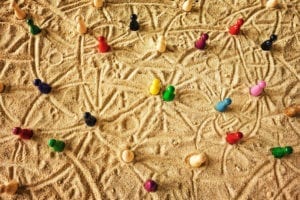When we are faced with learning something new, it is useful to use metaphors to help us play with different approaches and concepts.
Any organization that uses technology to connect employees, customers, and business is familiar with two internal structures: technology and the internal hierarchy. Technology is a networked structure. Imagine the internet; nodes connect in a lateral way to other nodes that spreads across the globe. Networks have different dynamics than hierarchies.
Nature is also a networked structure. It is interdependent, relationship rich, dynamic, and complex. When understanding the dynamics of networks and influencing change in a system, nature has a lot to teach us. Nature is changing all the time; that is the essential characteristic of a living system. When we are learning how to lead change, we can look to nature to learn how to facilitate it in networked organizations.
Wet Sand, Force, and Resistance
Wet sand demonstrates the relationship between force and resistance. Anyone who has walked on wet sand on a beach knows that their feet don’t completely sink. Wet sand is made up of saline and silicone. When we forcefully put our foot down on wet sand, it congeals and our foot encounters a hard surface. However, if we place a foot down and wait, eventually the sand separates and our foot sinks into the sand.

The composition of sand hasn’t changed, just its response to the force or lack of force we use in relation to it. The grains of sand held together by saline teaches us that a slow entry into a networked system will allow our foot to make an impression. Human networks have a similar response to force. Like wet sand, when we force change, we create resistance. However, if we nudge and wait, the organization and the humans in it will open to the change.
This is completely opposite to the traditional wisdom of driving change down from the top of the organization. Hierarchical organizations believe that change starts from the top. If leaders want to create change, they drive it with the force of positional power down the organization. If our organizations were pure hierarchies, this would work, however, human beings and living networked organizations also exist in our organizations.
We no longer are just hierarchies; our organizations are also strongly networked. When we force change, the network dynamic of organizational life takes over and generate resistance.
Nudge, Wait, and Attract
Resistance shows up when positional power forces a direction on us without adequate time to understand or be involved in the change process. Using the wisdom of networks, organizational leaders of living systems nudge and wait. They talk about the challenges facing the organization and allow time to for people to understand why it matters to them and the organization to respond to the challenge. There is time for people (not just some people) to help design, reshape, and implement the organizational change. People in living systems only pay attention to what matters to them here and now. They also only support solutions that they help to create.
The second strategy alongside “nudge and wait” is to attract people to the change the organization needs. Leaders attract people to ideas by appealing to their curiosity and their interest in supporting the whole organization.
The internet is a good place to study the dynamics of attraction. The whole system is based on a system of attraction, not push. Before the internet, we would get advertisements pushed to our home mailboxes. When the internet began to embed itself into our lives, people sitting in front of their monitors used their curiosity and interest to dictate what information they wanted to search for and what websites they wanted to visit. Websites, in turn, were designed to attract people to their sites with snazzy designs and relevant information. When a website or video goes viral, it is demonstrating the power of attraction. The item is shared along relationship lines within a network and spreads across the web.
Organizational leaders need to increase their capacity to attract (not force) people to their ideas. Once the attraction has been successful, then use the nudge and wait to allow time for people to respond to the ideas and direction of the needed change. If no one is attracted to your idea, then it is time to reflect on the merits of the idea in the first place.
Dr. Kathleen E. Allen writes a blog on leadership and organizations that describes a new paradigm of leadership that is based in lessons from nature and living systems. She is the author of Leading from the Roots: Nature Inspired Leadership Lessons for Today’s World (2018) and President of Allen and Associates, a consulting firm that specializes in leadership, innovation, and organizational change. You can sign up for her blog on her website: www.kathleenallen.net






